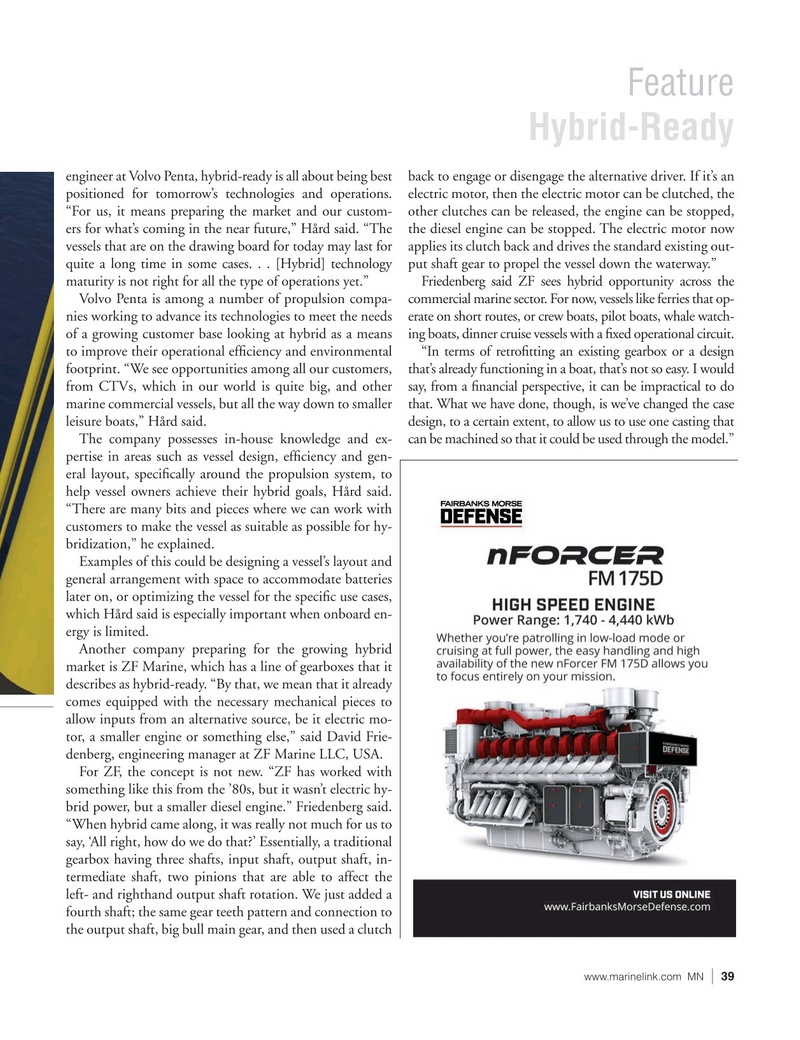
Page 39: of Marine News Magazine (February 2023)
Power & Propulsion
Read this page in Pdf, Flash or Html5 edition of February 2023 Marine News Magazine
Hybrid-Ready engineer at Volvo Penta, hybrid-ready is all about being best back to engage or disengage the alternative driver. If it’s an positioned for tomorrow’s technologies and operations. electric motor, then the electric motor can be clutched, the “For us, it means preparing the market and our custom- other clutches can be released, the engine can be stopped, ers for what’s coming in the near future,” Hård said. “The the diesel engine can be stopped. The electric motor now vessels that are on the drawing board for today may last for applies its clutch back and drives the standard existing out- quite a long time in some cases. . . [Hybrid] technology put shaft gear to propel the vessel down the waterway.” maturity is not right for all the type of operations yet.” Friedenberg said ZF sees hybrid opportunity across the
Volvo Penta is among a number of propulsion compa- commercial marine sector. For now, vessels like ferries that op- nies working to advance its technologies to meet the needs erate on short routes, or crew boats, pilot boats, whale watch- of a growing customer base looking at hybrid as a means ing boats, dinner cruise vessels with a ? xed operational circuit.
to improve their operational ef? ciency and environmental “In terms of retro? tting an existing gearbox or a design footprint. “We see opportunities among all our customers, that’s already functioning in a boat, that’s not so easy. I would from CTVs, which in our world is quite big, and other say, from a ? nancial perspective, it can be impractical to do marine commercial vessels, but all the way down to smaller that. What we have done, though, is we’ve changed the case leisure boats,” Hård said. design, to a certain extent, to allow us to use one casting that
The company possesses in-house knowledge and ex- can be machined so that it could be used through the model.” pertise in areas such as vessel design, ef? ciency and gen- eral layout, speci? cally around the propulsion system, to help vessel owners achieve their hybrid goals, Hård said. “There are many bits and pieces where we can work with customers to make the vessel as suitable as possible for hy- bridization,” he explained.
Examples of this could be designing a vessel’s layout and general arrangement with space to accommodate batteries later on, or optimizing the vessel for the speci? c use cases, which Hård said is especially important when onboard en- ergy is limited.
Another company preparing for the growing hybrid market is ZF Marine, which has a line of gearboxes that it describes as hybrid-ready. “By that, we mean that it already comes equipped with the necessary mechanical pieces to allow inputs from an alternative source, be it electric mo- tor, a smaller engine or something else,” said David Frie- denberg, engineering manager at ZF Marine LLC, USA.
For ZF, the concept is not new. “ZF has worked with something like this from the ’80s, but it wasn’t electric hy- brid power, but a smaller diesel engine.” Friedenberg said. “When hybrid came along, it was really not much for us to say, ‘All right, how do we do that?’ Essentially, a traditional gearbox having three shafts, input shaft, output shaft, in- termediate shaft, two pinions that are able to affect the left- and righthand output shaft rotation. We just added a fourth shaft; the same gear teeth pattern and connection to the output shaft, big bull main gear, and then used a clutch www.marinelink.com MN 39|

 38
38

 40
40
